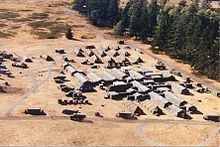
A combat support hospital (CSH, pronounced "cash") is a type of modern United States military field hospital. The CSH is transportable by aircraft and trucks and is normally delivered to the Corps Support Area in standard military-owned Demountable Containers (MILVAN) cargo containers. Once transported, it is assembled by the staff into a tent hospital to treat patients. Depending upon the operational environment (e.g., battlefield), a CSH might also treat civilians and wounded enemy soldiers. The CSH is the successor to the Mobile Army Surgical Hospital.
The size of a combat support hospital is not limited, since tents can be chained together; it will typically deploy with between 44 and 248 hospital beds, with 44 beds being most common (ATP 4.02-5 Casualty Care, May 2013) For patient care the CSH is climate-controlled, and has pharmacy, laboratory, X-Ray (often including a CT Scanner) and dental capabilities (ATP 4-02.5 Casualty Care, May 2013). It provides its own power from generators.